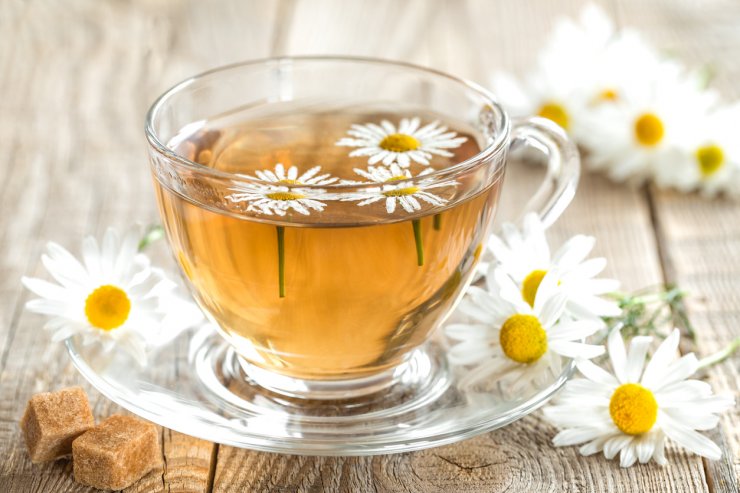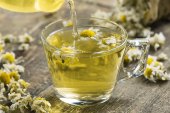
Chamomile tea is a popular bedtime beverage with a reputation for being a natural sleep aid. Chamomile even makes a cameo appearance in The Tale of Peter Rabbit. Peter Rabbit’s mother gives him a soothing cup of chamomile tea when he comes home after a close call in Mr. McGregor’s garden.
There are primarily two species of chamomile that people use for tea and other herbal endeavors: German chamomile and Roman, English, or garden chamomile.
German chamomile is an annual, but as long as you leave some flowers still standing after your harvest season, the remaining flowers will reseed the ground, and you’ll have more plants in the spring. Both species produce white and yellow, daisy-like flowers, but of the two species, German chamomile produces more flowers.
Roman/English/garden chamomile is a perennial. It provides rich, fragrant ground cover and a light sprinkling of flowers. If you really love chamomile tea, this species is a great choice for your garden because it will come up effortlessly each year.
Harvesting fresh chamomile for tea
Your chamomile harvest is ready when the flower petals are white, and the centers are bright yellow. The best times to harvest are early in the morning after the dew has evaporated from the flowers, or late in the evening—this is when the oils are most concentrated in the flowers.
Harvesting chamomile is a labor of love. You can pick the flowers one at a time or get a chamomile rake. As you pick your blossoms, collect them in a container that breathes, like a basket or paper bag. After you’ve finished harvesting, take the time to snip any stem parts off the blossoms; the stem can add a bitter edge to your tea. Also, look out for caterpillars!
Once you’re done harvesting your chamomile, start drying them right away. The most traditional way is to spread your chamomile flowers evenly in a single layer on a screen or woven basket and leave them in a cool, dry spot with good ventilation and no direct sunlight. Depending on your conditions, it can take up to two weeks for the flowers to dry completely. This is best for those who live in dryer climates, because chamomile is prone to mold.
For a simpler process, use a dehydrator. Spread the head out evenly and set them to dehydrate for 15 hours at 95 degrees F.
Once dry, store the dried chamomile in an airtight container for up to a year.
To make chamomile tea
You can buy all-in-one teapots that act as both infuser and strainer. Alternatively, if you don’t want to strain your tea after you’ve brewed it, you can tuck your chamomile flowers—fresh or dried—into a tea ball. They come in a variety of sizes. Some have a chain attached with a hook for hanging the tea ball in your mug; others look like teaspoons, with handles that you squeeze to open the hinged ball.
You’ll need just 2 teaspoons dried chamomile for a cup of hot boiling water—195 degrees F to 205 degrees F is best.
You can do the same with fresh chamomile, about a tablespoon per cup. The flowers, buds, and leaves are all edible, but I would stick to just the flowers and buds for tea and trim off as much stem as possible.
The most important thing to know about making chamomile tea is that you should only steep chamomile for two to three minutes or it will start to become bitter.
Print
Chamomile Tea
Soothing and delicately sweet, this Chamomile Tea uses home-dried chamomile and is the best drink to have when you want to sit back and relax!
- Prep Time: 15 minutes
- Cook Time: 10 minutes
- Total Time: 25 minutes
- Yield: Serves 1
- Category: Beverages
Ingredients
- 1 tablespoon fresh chamomile flowers, or 2 teaspoons dried blossoms
- 1 cup hot water
- Honey to taste, if desired
Instructions
- Heat water just to the boiling point.
- Add fresh or dried chamomile flowers to a tea ball or infuser.
- Pour water over the flowers into a mug or teacup.
- Cover the mug with a lid or saucer and let it steep for 3 minutes.
- Remove the infuser/tea ball and put the steeped flowers in the compost.
- Season tea with honey if you like.
- Sit back, sip, and relax!
If you’d like to learn more about growing your own chamomile tea, read our Chamomile Gardening Guide!
What are other tips you use for making chamomile tea? Leave a comment below.


 Previous
Previous

